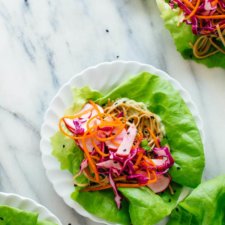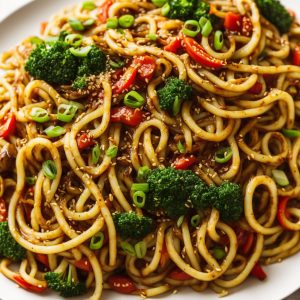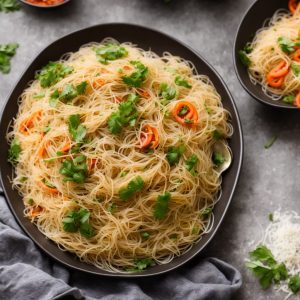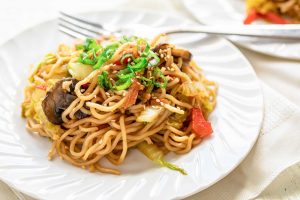This Veggie Sesame Noodles recipe is a delightful combination of flavors and textures. The soba noodles provide a hearty base, while the vibrant vegetables add crunch and freshness. The rich sesame dressing gives the whole dish a delicious depth of flavor. Perfect for a light lunch or a side dish for your main meal.

The key ingredient you might not commonly find in your pantry is soba noodles. Soba is a type of thin Japanese noodle made from buckwheat flour. It has a unique nutty flavor and is often used in soups and salads. You can find soba noodles in the Asian food section of most supermarkets. Also, toasted sesame oil used in this recipe has a more concentrated flavor than regular sesame oil and gives the dish a distinctive nutty taste.
Ingredients For Veggie Sesame Noodles
Soba noodles: A Japanese noodle variety made from buckwheat flour. They provide a hearty base for this dish.
Raw sesame seeds: Adds crunch and nuttiness to the dish.
Tamari: A type of soy sauce that's slightly thicker and less salty.
Toasted sesame oil: Imparts a deep, roasted flavor to the dish.
Lime juice: Adds a tangy freshness that brightens the flavors.
Fresh ginger: Adds a spicy, aromatic flavor.
Garlic: Enhances the overall flavor profile of the dish.
Red pepper flakes: Adds a bit of heat, but can be adjusted to taste.
Red cabbage, Carrots, Red bell pepper: Provide a variety of textures and colors, and add healthful nutrients.
Green onions: Adds a mild, sweet onion flavor.
Cilantro: Brings a fresh and citrusy flavor.
Edamame: Rich in protein and fiber, adds a nice pop of color and texture.
One reader, Darlene Justice says:





This veggie sesame noodles recipe is a game-changer! The flavors are so vibrant and the combination of veggies and sesame dressing is just perfect. It's a refreshing and satisfying dish that's become a regular in my meal rotation. Highly recommend trying it out!
Culinary Techniques for Crafting Veggie Sesame Noodles
How to cook soba noodles: Cook the soba noodles according to the package directions, ensuring they are al dente. Drain in a colander and rinse them well under cool water to stop the cooking process and prevent them from sticking together.
How to toast sesame seeds: Toast the sesame seeds in a small skillet over medium heat, stirring often. Once they become fragrant and turn golden, transfer them to a small bowl to prevent burning. Set aside to cool.
How to make the dressing: In a bowl, combine the tamari, sesame oil, lime juice, grated fresh ginger, minced garlic, and red pepper flakes. Whisk until all the ingredients are well blended to create the dressing for the noodles.
How to assemble the dish: Add the cooked soba noodles to a large serving bowl. Then, add the shredded red cabbage, julienned carrots, sliced red bell pepper, chopped green onions, cilantro, and shelled edamame to the bowl with the noodles. Drizzle the prepared dressing over the ingredients. Add the toasted sesame seeds and use tongs to toss everything together until the mixture is fully combined.
How to serve or store: Serve the veggie sesame noodles immediately, or refrigerate for later, ensuring to give it a good toss before serving if it has been refrigerated.
How To Make Veggie Sesame Noodles
For a completely vegan meal, make these veggie sesame noodles with a distinctly Asian flavor from the sesame oil, soy sauce, and the fermented edamame.
Serves:
Ingredients
- 8ozsoba noodles
- ¼cupraw sesame seeds
- ⅓cupreduced sodium tamari
- ¼cuptoasted sesame oil
- 2tbsplime juice
- 1tspgrated fresh ginger
- 2clovesgarlic,pressed or minced
- ½tspred pepper flakes,to taste
- 10ozred cabbage
- 1½cupscarrots,peeled and then sliced into ribbons with vegetable peeler
- 1red bell pepper,sliced into very thin strips
- 1bunchgreen onions,chopped
- ½cupcilantro,chopped
- 2cupsshelled edamame,steamed, optional
Instructions
-
Cook the soba noodles according to the package directions. Drain in a colander and rinse them well under cool water.
-
Transfer the drained noodles to a large serving bowl and set aside.
-
Meanwhile, toast the sesame seeds in a small skillet over medium heat, stirring often. Once fragrant and turning golden, transfer them to a small bowl to prevent burning. Set aside.
-
In another bowl, combine the tamari, sesame oil, lime juice, ginger, garlic and red pepper flakes. Whisk until blended. Set aside.
-
To assemble, add the cabbage, carrots, bell pepper, green onions, cilantro, and optional edamame to your bowl with the noodles. Drizzle in the dressing.
-
Add all of the sesame seeds, and use tongs to toss until the mixture is fully combined. Serve immediately, or refrigerate for later.
Nutrition
- Calories: 357.20kcal
- Fat: 15.30g
- Saturated Fat: 2.12g
- Trans Fat: 0.00g
- Monounsaturated Fat: 5.49g
- Polyunsaturated Fat: 6.41g
- Carbohydrates: 45.54g
- Fiber: 6.38g
- Sugar: 6.08g
- Protein: 15.43g
- Sodium: 1235.49mg
- Calcium: 157.26mg
- Potassium: 708.31mg
- Iron: 4.33mg
- Vitamin A: 327.14µg
- Vitamin C: 63.00mg
Expert Tip for Perfecting Veggie Sesame Noodles
When toasting sesame seeds, it's important to keep a close eye on them as they can burn quickly. The seeds are done when they're golden and fragrant. If they start to smoke, take them off the heat immediately. This will ensure your seeds have a nice, toasted flavor without any bitterness.
Time-Saving Tips for Preparing This Noodle Dish
Prep ahead: Chop and prepare all the vegetables and dressing ingredients in advance to streamline the cooking process.
One-pot cooking: Consider using a large pot to cook the noodles and blanch the vegetables simultaneously, saving time and reducing clean-up.
Quick-cook noodles: Opt for quick-cook noodles to cut down on cooking time without compromising on flavor or texture.
Efficient multitasking: While the noodles are cooking, use the time to prepare the dressing and chop the vegetables for maximum efficiency.
Batch cooking: Make a larger portion and store the leftovers for quick and convenient meals throughout the week.
Streamlined assembly: Organize your workspace and ingredients to assemble the dish efficiently, minimizing prep and clean-up time.
Substitute Ingredients For Veggie Sesame Noodles Recipe
soba noodles - Substitute with rice noodles: Rice noodles are a great gluten-free alternative to soba noodles and have a similar texture, making them a suitable substitute for this recipe.
raw sesame seeds - Substitute with toasted sesame seeds: Toasted sesame seeds will add a deeper, nuttier flavor to the dish, enhancing the overall taste and aroma.
reduced sodium tamari - Substitute with low-sodium soy sauce: Low-sodium soy sauce can be used as a substitute for tamari, providing a similar umami-rich flavor to the dish.
toasted sesame oil - Substitute with peanut oil: Peanut oil can be used as a substitute for toasted sesame oil, offering a mild nutty flavor that complements the other ingredients in the recipe.
lime juice - Substitute with rice vinegar: Rice vinegar can be used as a substitute for lime juice, providing a tangy and slightly sweet flavor to the dish.
grated fresh ginger - Substitute with ground ginger: Ground ginger can be used as a substitute for fresh ginger, providing a similar warm and spicy flavor to the dish.
garlic - Substitute with garlic powder: Garlic powder can be used as a substitute for fresh garlic, adding a milder garlic flavor to the dish.
red pepper flakes - Substitute with sriracha: Sriracha can be used as a substitute for red pepper flakes, adding heat and a hint of garlic flavor to the dish.
red cabbage - Substitute with napa cabbage: Napa cabbage can be used as a substitute for red cabbage, providing a similar crunchy texture and mild, sweet flavor to the dish.
carrots - Substitute with jicama: Jicama can be used as a substitute for carrots, offering a crisp texture and a slightly sweet, nutty flavor to the dish.
red bell pepper - Substitute with orange bell pepper: Orange bell pepper can be used as a substitute for red bell pepper, providing a similar crunchy texture and sweet flavor to the dish.
green onions - Substitute with chives: Chives can be used as a substitute for green onions, offering a mild onion flavor and a delicate texture to the dish.
cilantro - Substitute with parsley: Parsley can be used as a substitute for cilantro, providing a fresh, herbaceous flavor to the dish.
shelled edamame - Substitute with frozen green peas: Frozen green peas can be used as a substitute for edamame, offering a similar sweet and slightly crunchy texture to the dish.
Presenting Veggie Sesame Noodles for Maximum Appeal
Elevate the plating: When presenting the veggie sesame noodles, focus on creating a visually appealing plate. Use a large, shallow bowl to showcase the vibrant colors and textures of the dish. Arrange the noodles and vegetables thoughtfully, ensuring a balanced and harmonious presentation.
Incorporate edible garnishes: Enhance the visual appeal of the dish by incorporating edible garnishes such as microgreens or sesame seeds. These elements not only add a pop of color but also provide a textural contrast, elevating the overall presentation.
Focus on precision: Pay attention to the placement of each component on the plate. Aim for precision and artistry in arranging the noodles, vegetables, and garnishes. A meticulous presentation demonstrates attention to detail and culinary finesse.
Highlight the freshness: Emphasize the freshness of the ingredients by ensuring that the vegetables are vibrant and the noodles are glistening with the sesame dressing. A fresh and inviting appearance sets the stage for an exceptional dining experience.
Consider the vessel: Select a vessel that complements the aesthetic of the dish. A contemporary, minimalist bowl or a traditional Japanese-style plate can enhance the presentation, allowing the vibrant colors of the veggie sesame noodles to take center stage.
Emphasize balance and harmony: Strive for a balanced composition, ensuring that the elements are distributed evenly and harmoniously across the plate. A visually balanced presentation creates a sense of abundance and sophistication.
Essential Kitchen Tools for Making Veggie Sesame Noodles
- Saucepan: A deep cooking pan with a handle, used for cooking on the stovetop.
- Colander: A bowl-shaped kitchen utensil with holes in it used for draining food such as pasta or rice.
- Skillet: A flat-bottomed pan used for frying, searing, and browning foods.
- Whisk: A kitchen utensil used for whipping and mixing ingredients such as eggs, sauces, and batters.
- Tongs: A tool with two arms and a pivot near the handle, used for picking up and manipulating food.
- Cutting board: A durable board on which to place material for cutting.
- Knife: A sharp-edged tool used for cutting or slicing food.
- Grater: A kitchen utensil with sharp-edged holes used for shredding or grating food.
- Serving bowl: A large bowl used for serving food.
- Small skillet: A smaller version of a skillet, used for toasting seeds or nuts.
- Mixing bowl: A bowl used for mixing ingredients.
- Food processor: An electric kitchen appliance used for chopping, mixing, or pureeing ingredients.
- Small bowl: A smaller-sized bowl used for mixing or holding small amounts of ingredients.
- Measuring cups: Used to measure the volume of liquid or solid cooking ingredients.
- Measuring spoons: Used to measure a small amount of an ingredient.
- Spatula: A kitchen tool with a broad, flat, blunt blade, used for mixing, spreading, and turning food.
- Ladle: A long-handled spoon with a deep bowl for serving soup or sauce.
Storing and Freezing Veggie Sesame Noodles for Later
These veggie sesame noodles can be stored in an airtight container in the refrigerator for up to 4 days. The flavors will meld together and intensify over time, making them even more delicious the next day.
If you plan to make this dish ahead of time for a party or meal prep, it's best to store the noodles, vegetables, and dressing separately. Toss them together just before serving to prevent the noodles from becoming soggy.
For longer storage, you can freeze the noodles and vegetables in separate freezer-safe containers for up to 2 months. Thaw them in the refrigerator overnight before tossing with the dressing and serving.
If you have leftover sesame seeds, store them in an airtight container in a cool, dry place for up to 3 months. They can be used to add a nutty crunch to salads, stir-fries, or baked goods.
The dressing can be made ahead of time and stored in a jar or airtight container in the refrigerator for up to 1 week. Give it a good shake or whisk before using to redistribute any separated ingredients.
How To Reheat Leftover Veggie Sesame Noodles
To reheat leftover veggie sesame noodles, start by placing the desired portion in a microwave-safe bowl. Cover the bowl with a damp paper towel to prevent the noodles from drying out during the reheating process. Microwave on high for 1-2 minutes, or until the noodles are heated through. Stir the noodles halfway through the reheating time to ensure even heating. Once hot, give the noodles a quick toss to redistribute the sesame dressing and enjoy!
For a stove-top method, place the leftover sesame noodles in a large skillet or wok over medium heat. Add a splash of water or vegetable broth to the pan to help loosen up the noodles and prevent them from sticking. Stir the noodles frequently, using tongs to separate any clumps. Cook for 3-5 minutes, or until the noodles are heated through and the vegetables are tender-crisp. If the noodles seem dry, add a bit more liquid or a drizzle of sesame oil to revive the flavors.
If you prefer a cold noodle salad, simply remove the leftover veggie sesame noodles from the refrigerator and allow them to come to room temperature for about 15-20 minutes. This will help the flavors to develop and the noodles to soften slightly. Give the noodles a good toss to redistribute the dressing and vegetables. If the noodles seem a bit dry, whisk together a small amount of tamari, sesame oil, and lime juice to create a quick dressing. Drizzle this over the noodles and toss to combine before serving.
Fascinating Trivia About Veggie Sesame Noodles
The recipe contains soba noodles, which are a type of Japanese noodle made from buckwheat flour. They are a good source of nutrients such as manganese, lean protein, and fiber.
Budget-Friendly: Is This Noodle Recipe Economical?
This veggie sesame noodles recipe is highly cost-effective for a household. With affordable ingredients like soba noodles, sesame seeds, and vegetables, it offers a budget-friendly meal option. The versatility of the recipe allows for ingredient substitutions based on seasonal availability, further enhancing its cost-effectiveness. The overall verdict rating for this recipe is 9/10, considering its nutritional value, flavor, and affordability. The approximate cost for a household of 4 people is around $15, making it an economical choice for a satisfying and wholesome meal.
Are Veggie Sesame Noodles Healthy?
This veggie sesame noodles recipe is a nutritious and well-balanced dish that incorporates a variety of healthy ingredients. The use of soba noodles, which are made from buckwheat, provides a good source of complex carbohydrates and fiber. The abundance of vegetables, such as red cabbage, carrots, bell pepper, and green onions, offers a wide range of vitamins, minerals, and antioxidants. The inclusion of edamame adds a plant-based protein source to the meal, making it more satiating and balanced.
The dressing, made with tamari, sesame oil, lime juice, ginger, garlic, and red pepper flakes, is flavorful and low in calories. The use of reduced-sodium tamari helps to control the dish's salt content. Sesame oil is rich in healthy fats and provides a nutty flavor to the noodles.
To further enhance the nutritional value of this recipe, consider the following suggestions:
- Increase the variety of vegetables by adding more nutrient-dense options like broccoli, snap peas, or mushrooms
- Replace a portion of the soba noodles with spiralized zucchini or carrots to reduce the overall carbohydrate content and increase the vegetable intake
- Include a lean protein source, such as grilled chicken or tofu, to make the dish more satisfying and balanced
- Reduce the amount of sesame oil in the dressing and replace it with a lower-calorie alternative, such as rice vinegar or additional lime juice
- Garnish the dish with fresh herbs like basil or mint to add more flavor and antioxidants
Editor's Take: My Honest Opinion on Veggie Sesame Noodles
This veggie sesame noodles recipe is a delightful fusion of flavors and textures. The combination of soba noodles, fresh vegetables, and a zesty sesame dressing creates a harmonious dish that is both satisfying and nutritious. The use of toasted sesame seeds adds a delightful crunch, while the edamame provides a boost of protein. The balance of savory, tangy, and spicy elements in the dressing elevates the overall dish. It's a versatile recipe that can be enjoyed as a main dish or a side, making it perfect for any occasion.
Why trust this Veggie Sesame Noodles Recipe:
This recipe offers a delightful combination of flavors and textures, making it a delectable choice for any occasion. The use of soba noodles provides a nutritious base, while the addition of sesame seeds and toasted sesame oil infuses the dish with a rich, nutty essence. The tamari and lime juice contribute a delightful tang, complemented by the warmth of grated fresh ginger and garlic. The colorful array of red cabbage, carrots, red bell pepper, green onions, and cilantro not only enhances the visual appeal but also ensures a diverse range of nutrients. Lastly, the inclusion of shelled edamame adds a satisfying touch of protein.
Was this page helpful?
Have your own special recipe to share? Submit Your Recipe Today!











